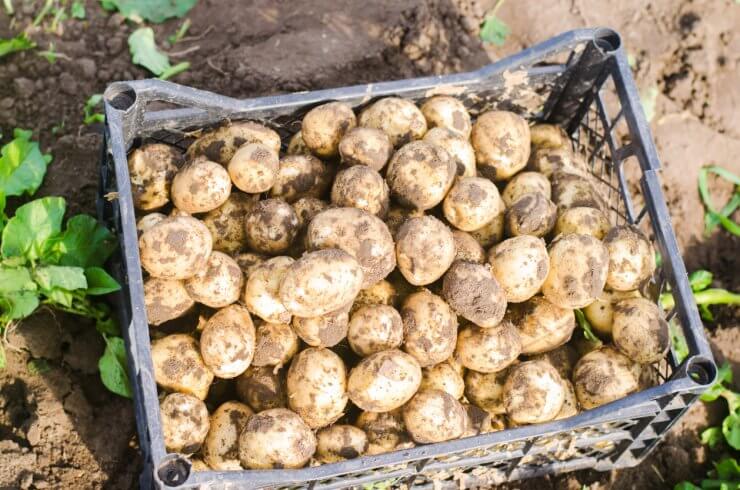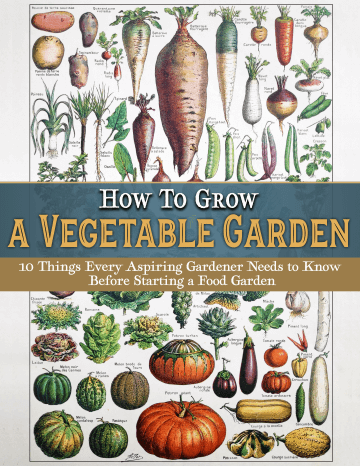
As a New Englander by adoption, I’m fascinated by—and proud of—almost everything New England, including our rich history of potato farming. And when it comes to the king of New England potatoes, one variety rises above the rest: the Kennebec Potato.
Born in 1941 in Maine, this all-purpose white potato was developed by the USDA and quickly became a favorite for home gardeners and chefs alike. It’s reliable, adaptable, and downright delicious, making it a spud worth celebrating. If there were a Hall of Fame for potatoes, the Kennebec would have its own wing.
Discover 10 top tips for growing, harvesting, and enjoying fruits, vegetables, herbs and more from your home garden—when you access the FREEBIE How to Grow a Vegetable Garden, right now!
The Kennebec Potato: A Spud Worth Knowing
First, let’s talk history. The Kennebec potato is named after the Kennebec River in Maine—because, apparently, nothing screams “future French fries” like a strong New England waterway. It was bred for its high yields, disease resistance, and exceptional flavor. Unlike those diva potatoes that demand perfect conditions, the Kennebec is a hardworking, no-nonsense tuber that thrives in home gardens across the U.S.
Some fun facts about this legendary spud:
- It’s a Chef’s Favorite – You’ll find Kennebecs in everything from gourmet potato chips to five-star fries. In fact, some of the best French fries in America are made from Kennebecs (In-N-Out Burger, I’m looking at you).
- Disease Resistance – While some potatoes throw in the towel at the first sign of blight, the Kennebec is a fighter, resisting common potato ailments like early blight, late blight, and viral diseases.
- Excellent Storage Life – Harvest these beauties in the fall, and they’ll still be firm and tasty well into the winter months.
- Perfect for Home Gardeners – Whether you’re planting in containers, raised beds, or in the ground, the Kennebec adapts beautifully.
With that in mind, let’s dig into (pun fully intended) how to plant, grow, harvest, and eat the best Kennebec potatoes ever.
How to Grow Kennebec Potatoes Like a Pro
If you want to grow Kennebec potatoes, you’re in for a treat. These potatoes are easy to cultivate, forgiving of minor gardening mistakes (bless them), and produce large, uniform tubers that make you look like a gardening genius.
Step 1: Selecting Your Kennebec Seed Potatoes
Unlike grocery store potatoes, which may be treated with sprout inhibitors, certified seed potatoes from a reputable supplier will ensure a healthy start. Look for firm, disease-free tubers.
Pro tip: Cut large seed potatoes into chunks with at least one or two “eyes” per piece and let them cure for 24-48 hours before planting. This reduces the risk of rot.
Step 2: Planting the Mighty Kennebec
- Best Time to Plant: Early spring, once the soil temperature reaches 50°F (because nobody likes cold feet, not even potatoes).
- Soil Prep: Well-draining, loamy soil with plenty of organic matter. Kennebecs are hungry spuds, so mix in compost or aged manure before planting.
- Spacing: Plant seed pieces 12 inches apart in rows that are about 3 feet apart.
- Depth: Bury them 3-4 inches deep in trenches, and cover them with soil.
Step 3: Growing and Caring for Your Potatoes
- Watering: Potatoes like consistent moisture but hate soggy roots. Water deeply once or twice a week, especially during hot weather.
- Hilling: Once your potato plants are about 6-8 inches tall, start hilling soil around the base of the plants. This keeps the tubers covered and prevents them from turning green (unless you want a science experiment instead of dinner).
- Fertilizing: Use a balanced organic fertilizer (something like 10-10-10) at planting and again mid-season. Avoid too much nitrogen, or you’ll get all leaves and no potatoes.
Step 4: Harvesting Your Kennebec Gold
- New Potatoes: If you can’t wait (and let’s be honest, who can?), you can start harvesting baby potatoes 60 days after planting.
- Mature Potatoes: Full-sized Kennebecs are ready 90-100 days after planting when the vines have died back. Let them cure in the ground for a few days before digging them up.
- Storage: Store in a cool, dark, well-ventilated space. If stored properly, they’ll last up to 6 months.
Where Kennebec Potatoes Excel in the Kitchen
What makes Kennebec potatoes so special? Their texture—dense yet fluffy, with a creamy white interior that holds up to various cooking methods. Here’s where they shine:
French Fries – Hands down, some of the crispiest, most flavorful fries come from Kennebec potatoes. They hold their shape and get that perfect golden crunch.
Mashed Potatoes – Creamy, smooth, and buttery without turning gluey (looking at you, overworked Russets).
Potato Chips – If you’ve ever had a gourmet kettle-cooked chip, chances are it was made with Kennebecs.
Baked Potatoes – A Kennebec baked potato is a meal in itself, with a perfectly crisp skin and fluffy interior.
Roasted Potatoes – Cut into wedges, tossed in olive oil and herbs, and roasted to perfection—pure heaven.
Soups & Stews – Holds its shape beautifully, making it the perfect potato for chowders and stews.
Final Thoughts & Spud-Tastic Advice
If you’re looking for one potato to rule them all, Kennebec is your champion. It’s easy to grow, adaptable to different garden settings (containers, raised beds, in-ground), and incredibly versatile in the kitchen.
Whether you’re making homemade French fries, buttery mashed potatoes, or roasting them with rosemary and olive oil, Kennebec potatoes are a food gardener’s dream.
So, why not give them a try? Your taste buds (and your dinner guests) will thank you.
Want More Potato Wisdom?
Check out our comprehensive guide for more tips on growing, harvesting, and cooking the best potatoes and sweet potatoes ever!
Now go forth and plant some Kennebecs! Your garden (and your dinner table) will never be the same.





I have looked and looked but can’t find a source for the seeds. Any suggestions? Thank you in advance. ????
Seed potatoes are available at a variety of nurseries and online sites (Gurneys, Burpee, Johnny’s Selected Seed). I always get mine from my local Agway (shop local – yeah!). The key is to shop early – seed potatoes usually show up in late April in New England but they go quickly.